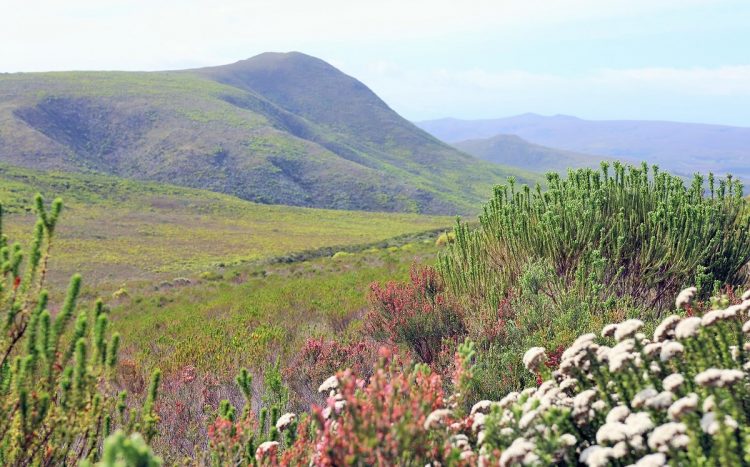Posted in Accommodation, Adventure travel, Blog, Bushwalking, Conservation, Ecotourism, National Parks, South Africa, Wildlife Tags: Cape Floral, conservation, David Bellamy, ecotourism, experiences, fynbos, Gansbaai, Grootbos, Grootbos foundation, nature reserve, South Africa, UNESCO, world heritage-listed
Reserved for Nature
WORDS & IMAGES: MARIE BARBIERI
For a luxury lodge that is also a world leader in sustainable ecotourism, head to Grootbos Private Nature Reserve in the heart of South Africa’s Cape Floral Region.
The sage-infused bathwater rises and falls with my breath as I watch a cape sugarbird from my bathtub. A four-poster bed stands draped in curtains that sway in the sea breeze. And plump robes hang beneath sun-speared skylights.

Grootbos Private Nature Reserve welcomes guests with extravagant comforts. Yet this five-star retreat’s primary focus is to protect and nurture the unique and endangered indigenous flora within which it sits. On my dressing table lays a book made onsite: Field Guide to the Flora of Grootbos Nature Reserve and the Walker Bay Region. Penned by Sean Privett (private botanist to Grootbos owner, Michael Lutzeyer) and illustrated by Heiner Lutzeyer (Michael’s father), it’s a beautifully assembled catalogue of the property’s biodiverse habitat.

Overlooking the fynbos-carpeted slopes during lunch, I meet Sean himself. He immediately waxes lyrical about this eco-sensitive area.
“In the UK, there are 1,550 species of flora,” he says. “In the Cape, there are 9,500: 6,500 being endemic. And six species new to science were found at Grootbos, such as erica magnisylvae (grootbos erica), which I discovered in 1997.”
Inspired, I head straight into the fynbos wilderness.
Upon the fields of fynbos
Nash, our guide, seats us in his open-air Land Rover. We bounce along the reserve’s old farm tracks where to date, 786 identified indigenous floral species thrive. The fynbos biome is botanically diverse. This fine evergreen bush produces proteas, ericas and restios. Two thirds of the world’s restionaceae plants are found in the UNESCO World Heritage-listed Cape Floral Region (with 21 of the species growing at Grootbos).

We halt at the adorable baby pink blooms of endemic erica irregularis (Gansbaai heath). It’s a vulnerable shrub, with 80% of its local population growing only on Grootbos.
Nash points out the protea cynaroides (king protea). It’s South Africa’s national flower and desired the world over. Resembling a globe artichoke in red bracts, its striking head encases a bonsai-sized garden of flowers, yet the plant can grow two metres high.

Leucospermum patersonii (silver-edge pincushion)—another protea—is becoming increasingly extinct outside Grootbos. The endemic long-beaked sugarbird spreads the flower’s pollen after extracting nectar. When its seeds fall, ants transfer them to nests, to feast on their coating. Then, during the first winter after fire, the abandoned seeds germinate.
“Without birds, ants and fire,” says Nash, “we wouldn’t have this beautiful plant.”
A rare sight is the pterygodium vermiferum (coryciinae orchid), a species that Heiner Lutzeyer discovered in 2003. It’s not in flower today, as that only happens post-fire, during spring. Masterfully, it self-pollinates by collecting and dropping pollen onto its own stigma.
“Now, salvia africana-lutea (brown sage) should be familiar to you?” Nash asks, plucking leaves from a bush. “When the sunbird pushes its beak into the orange flowers, the hinged anther lands pollen onto its head, ideal for propagation. This sage is also used in the products in your bathrooms!”

Fynbos on foot
Parking the wheels, we plant our heels on a hiking trail in elevated fynbos country.
“I saw mountain leopard tracks here two days ago,” says Nash, his eyes scanning the ground. He points out a porcupine burrow and nearby baboon droppings, before picking up a mountain white spot caterpillar, with spiky black hairs and a striped orange face. It’s most attractive.

“I’ve also seen a caracal, honey badgers and the small bushbuck antelope here.” Alas, such creatures remain covert today.
We do hear the raucous whistle of a fork-tailed drongo, however. Like the Australian lyrebird, it impersonates, but with the intention to confuse, deceive and steal from other birds.
Daylight fades as we needle through the Western Cape variety of endangered milkwood forest. Its endemic trees—some over 800 years old—are protectively cloaked in moss. “This lichen moss grows only in clean air,” says Nash.
During his visit to Grootbos, British environmentalist, David Bellamy OBE, described the private reserve as the best example of conservation of biodiversity he’d ever seen. Watching an orange sunset creep across the fynbos before me, I believe him.
The Grootbos Foundation
Part of the 2004-established non-profit Grootbos Foundation is the Green Futures Horticulture and Life Skills College. Every year, 12 unemployed adults from disadvantaged communities are taught conservation practices, such as replacing invasive species with indigenous landscaping.

Running since 2009 is the Siyakhula Organic Farm. Here, husbandry skills are taught, to include: organic free-range pig and egg production, managing fynbos honey beehives, and tending orchards for sustenance farming. Produce is sold to local markets and the restaurants at Grootbos. Both courses also integrate business skills, health education and AIDS awareness.

In 2008, working in conjunction with the Football Foundation of South Africa, Grootbos helped build a soccer pitch in nearby Gansbaai. The award-winning project has empowered 3,500 children with physical skills and an integrative, interracial social and cultural life at the border of three racially segregated areas.
FOR MORE:
Grootbos Private Nature Reserve’s suites feature open fireplaces, private decks and outdoor showers. There’s not a plastic bin-liner in sight, and water bottles are made of aluminium, with their naturally filtered groundwater bottled onsite. Prices start at AU$340 per night, inclusive of meals and guided adventures.
www.grootbos.com
MARIE BARBIERI
Based in Adelaide, the festival city, Marie is an award-winning freelance writer and photographer who contributes to various travel and health publications. She has a passion for wildlife and conservation, and enjoys hiking and cycling.
Join us on Our Planet Travel’s eco adventure:
www.facebook.com/OurPlanetTravel
www.Instagram.com/OurPlanetTravel
www.twitter.com/OurPlanetTravel






